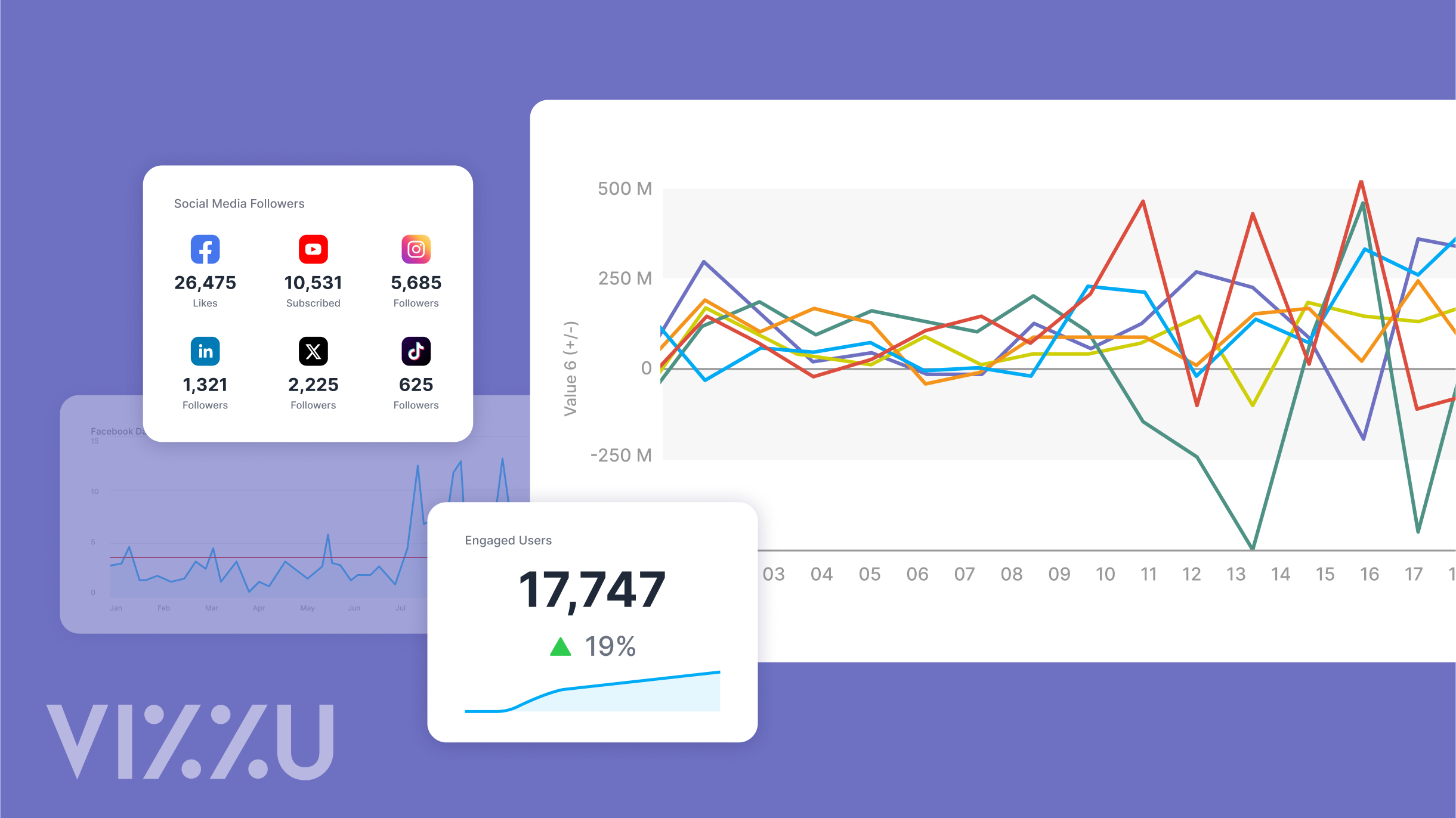
There’s a common misconception that data visualizations are time-consuming to make.
Following on from this mistaken belief is another misconception that says creating data visualizations for social media isn’t worth the effort.
Both of these beliefs couldn’t be further from the truth.
For starters, it’s never been easier and quicker to create attractive data visualizations and social media charts and graphs by using tools like Canva and Vizzu.
And it is definitely worth the effort, as a well-known study showed 65% of people recalled visual information after three days, compared to just 10 to 20% who consumed spoken or written content.
In the short-attention span world of social media, using data visualizations can stand out and is more memorable than plain data.
In this guide, we’re going to discuss the benefits and pitfalls of creating and preparing data visualizations for sharing on social media, as well as guiding you to tools that can help along the way.
Should You Post Data Visualizations On Social Media?
The simple answer is – yes, you should share data visualizations on social media. They often make for share-worthy posts that drive up engagement.
When creating social media data visualizations there’s a golden rule to follow:
Keep the social media user in mind. Put yourself in their shoes.
Ask yourself – what would make you stop scrolling and pay attention? A bland, lifeless post or a colorful interactive data visualization?
As people’s attention spans get shorter, quick, easy-to-understand data insights will become more attractive to users. So, be sure to give them what they want!
Having said that, you also need to pay close attention to data integrity. In today’s world of fake news and misinformation, even an honest mistake can cause big problems. In other words, never set out to mislead people. Social media charts and graphs that are designed to trick people will damage your brand if you’re not careful.
If you know your audience well, you can tailor data visualizations to meet their exact needs and interests, without being misleading. For instance, if your audience is mostly health and fitness enthusiasts, presenting data visualizations on workout trends or nutrition could be a winner.
Similarly, if your audience includes businesspeople, visualizations of market trends, economic indicators, or performance metrics are particularly effective. These need to be precise and to the point, using clear labels and conservative color schemes to maintain professionalism and clarity.
Benefits of Posting Data Visualizations on Social Media
Data visualizations are a great way to break through the noise on social media. Here's a breakdown of exactly why they're a smart addition to your social media content strategy:
- Boost Engagement: Visual content is more eye-catching than plain text. Charts, graphs, and infographics stand out in a feed, making people more likely to pause, interact, and share your posts.
- Enhance Understanding: Our brains process visuals much faster than text alone. Well-designed data visualizations make complex information readily understandable, encouraging your audience to grasp the key takeaways quickly.
- Increase Memorability: Shared charts on social media and interactive data visualizations can leave a lasting impression, making your insights stick in the minds of your followers.
- Build Authority: Sharing data-driven content demonstrates that you're not just expressing opinions, but backing up your claims with evidence. This establishes you as a credible and trustworthy source or thought-leader within your niche.
- Drive Conversation: Interesting data visualizations often spark discussions and debates. This means your busy comments section will send a signal to the algorithms that your content is compelling, further boosting its visibility.
Creating Charts And Graphs For Social Media Data Visualizations – Where To Start?
Make your visualization clear
For social media visualizations, it’s best to keep things simple and uncluttered. Think simple colors, clear labels, and a focus on the core message. Remember, most people will be glancing at this on a small phone screen, so make it count!
In terms of color, start with a black and white base for clarity. Then, use 1-2 accent colors to highlight key data points or trends. For complex visualizations, consider using well-designed color palettes.
Know your audience
The secret to a good data visualization for social media is knowing what makes your audience tick.
- Which topics interest them most?
- Are they number nerds or big-picture thinkers?
- Are there certain aspects of the data that they are more interested in?
Basically, make sure you tailor your visualizations to grab their interest and make the data relevant to them.
Optimize for each platform
Square or vertical images work well on Instagram. LinkedIn favors horizontal layouts for more in-depth charts. Twitter is flexible, but always check how your visualization previews before posting.
Ensure your files are in the formats supported by each platform (JPG, PNG, GIF, etc.) and keep file sizes as small as possible for quick loading.
Use interactive elements
Interactive features bring your data visualizations to life, so wherever possible, incorporate elements like these:
- Hover-Over Details: If possible, add pop-ups with additional information when users hover over specific points. Interactive elements like this can be added to Facebook and Instagram posts.
- Clickable Areas: Let users click to explore different data subsets or change chart views.
- Animations: Simple transitions (think bars growing in a bar chart) can make data more engaging and trends easier to follow.
Vizzu specializes in animation and interactive elements, making it ideal for social media visualizations.
Tell a story with your data
A data visualization can do more than simply present facts and figures. Turn your visualization into a mini-narrative:
- Ask a Question: Frame your visualization around a question relevant to your audience.
- Show a Trend: Highlight changes over time, surprising patterns, or interesting comparisons with shared charts on social media.
- Lead to an Insight: Don't just dump data on people; guide them to the "a-ha!" moment.
- Call to Action: If appropriate, include a subtle prompt for users to like, share, comment, or learn more.
For a more detailed look at data storytelling, click here.
Social media data visualization examples
Throwing down some Superbowl stats
Animated data visualizations are a fun way to share data stories on social media. Video content does well on platforms such as LinkedIn, Facebook, YouTube, and TikTok.
The example shown below shares stats related to Super Bowl LVIII. Rather than just talking about the data, the animation showed how the 49ers were poised to get 6 wins and join the Patriots and the Steelers in that particular hall of fame. It also speculated whether Mahomes would secure a third victory. As it turned out, Kansas City Chiefs beat the 49ers, and Mahomes threw a walk-off touchdown to Hardman in overtime.
Perfect for a coffee break…
Twitter or X is a great place to share short, engaging animated data visualizations. Videos or GIFs work well, as they entice people to click and engage, and are ideal for data storytelling. The Twitter (X) post shown below is an entertaining look at Vizzu’s coffee break stats.
Posting about social media on… social media
Another eye-catching animated data visualization, this one charts the growth of Vizzu CEO and Co-Founder, Peter Vidos, on LinkedIn. He recently reached 3000 followers on the platform, and rather than sharing a standard celebratory post, he created a cool data story using Vizzu, which you can check out below.
And the award for best data visualization goes to…
If you’re looking for a great example of a data story told through an engaging animated data visualization, then look no further than this one about the Oscars on Vizzu’s Youtube channel. It reveals how the highest grossing movies of the past 30 years, don’t often tally with the best picture winner at the Oscars.
The hidden beauty of city traffic…
See how traffic stops can be turned into a mesmerizing mandala, with this strangely beautiful animated data visualization from Vizzu’s Twitter (X) feed.
Laughter is the best medicine
On social media – if in doubt, use humor. People typically scroll through social media to be entertained. So give them what they want with humorous data visualizations like the pie chart post below.
Vizzu – Your Secret Weapon for Social Media Data Visualizations
Vizzu is the perfect tool for turning dry data into social media-ready stories.
The last thing you want to do on social media is bore people with static social media charts and graphs. Vizzu makes it easier than ever to create dynamic and interactive data visualizations. The drag-and-drop interface and intelligent chart suggestions let you create engaging posts within minutes.
You can easily add smooth animated transitions that guide people through the data and highlight key insights. The colorful eye-catching data visualizations are ideal for stopping people in their tracks when scrolling through their social feeds.
As well as being an easy-to-use and flexible tool, Vizzu is also supported by a large community of users and developers. This means it is continuously improving and adding new features and tools to make it even better.
Get Attention with Data Visualizations for Social Media
Data is abundant. Attention is scarce.
It’s no secret that people’s attention spans are dropping in the internet age. That’s why you need to use storytelling if you want to make a point on social media platforms.
But it’s no good just saying “The data says this…” or “We discovered this…”
Interactive or animated data visualizations tell the story in a much more engaging way. Vizzu is a nifty tool that makes it easy to make attention-grabbing data visualizations for social media.
Get Started Here - access all features for free.


